Opening note
Hello again!
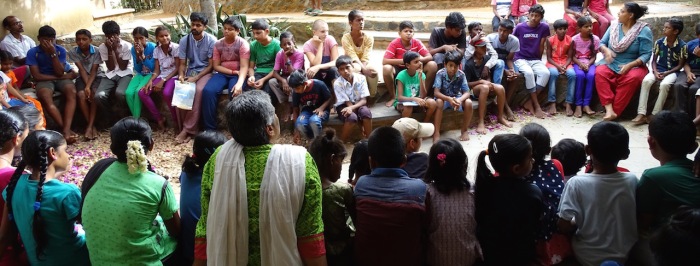
The first term of the school year has flown by, making the picture above (depicting the first assembly of the year, everyone fresh from a long summer break) seem from a long way back. But here we are, ready to conquer yet another Marudam school year, fully open to learn, explore and grow.
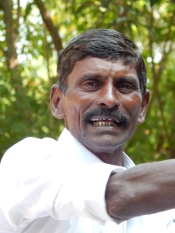
And just before you proceed to read the articles and the news we wish to take a moment and light a memory candle for one of our dear workers who is not with us anymore. It will be Raman’s first death anniversary on the 17th of October 2018. Raman from Adiyur, who is a close relative of Masilamani, has worked with us for over 10 years. Immensely loved by all and always ready to crack a joke, he died from a heart attack while getting ready for work.
May his memory be blessed.
Bulletin news

It was with great joy and excitement that we all put our finest garments one summer day, and joined the celebration of Sandhya and Pachaiappan’s long-awaited-for wedding function! Both are long term and well loved teachers at Marudam, theirs is a true love story. We wish them all the best for a happy married life!
=====================================================================
 A new toddler-dedicated area was inaugurated at the children park. By the shade of the baobab tree there appeared a small mound, a tunnel, a slide, climbing frame and all, decorated by a mosaic work done b
A new toddler-dedicated area was inaugurated at the children park. By the shade of the baobab tree there appeared a small mound, a tunnel, a slide, climbing frame and all, decorated by a mosaic work done b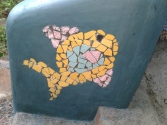 y students and teachers of Marudam.
y students and teachers of Marudam.
=========

During the months of July-August a bunch of us at Marudam have had a real treat in the form of Salsa classes… Our teacher was Karen, a volunteer from Colombia.Besides teaching us Salsa with great gusto, she also contributed to our nature database collecting and sharing.
=====================================================================
On a fine Saturday afterno on we held a first-class concert at the school featuring Bindhumalini – a Carnatic and Hindustani singer from Chennai, and Shanti – a Baul singer who is also a parent and a Music teacher at Marudam. Attended by parents, children, teachers and even the community dogs, it was a memorable and sublime experience.
on we held a first-class concert at the school featuring Bindhumalini – a Carnatic and Hindustani singer from Chennai, and Shanti – a Baul singer who is also a parent and a Music teacher at Marudam. Attended by parents, children, teachers and even the community dogs, it was a memorable and sublime experience.
=====================================================================
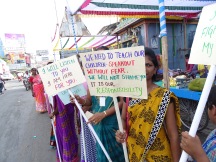
It was on a hot summer day in April that a group of us joined a demonstration for child’s rights and against sexual abuse, at the wake of the brutal rape of Asifa, an 8 year old girl from Kashmir.
=============================================
and last but not least – We are happy to announce that this year’s Crafts Week will be held between the 27th of October and 2nd of November. For queries please write to marudamfarmschool@gmail.com
Community store/ Kartik, Kamalakanan and Arun
Our community store is by far the fast emerging star of Marudam, and turning out to be one of our best outreach initiatives as well.
The store begun three years ago with few simple and some complex ideas behind it.
At the simplest, it was an initiative to fulfill the essential grocery needs of our community. On a deeper level, it aimed at an exploration of where our food comes from. Practically it meant avoiding middlemen, particularly in the form of large corporations, as well as avoiding plastic packaging. To achieve this, sourcing from small farmers in the neighbourhood became a noble aim in itself.
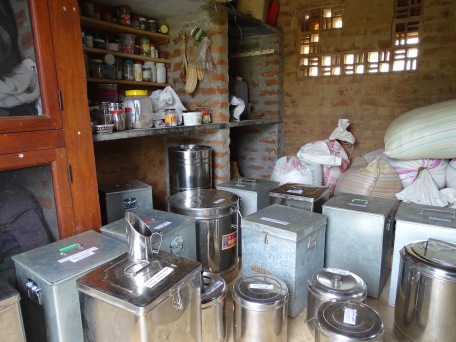
There were many life affirming ideas woven in to these objectives. For example, by sourcing groceries locally we dramatically reduce food mileage while moving in the direction of strengthening the local economy, even if in a small way. Small farmers are known to be one of the most exploited factions of society as they get abominably poor returns on their labour, and are at the complete mercy of the middlemen. Often they get so little that it doesn’t even cover their cost of growing the food. To remedy this, we are committed to buying at a rate which is fair by the farmer (known as Fair Trade), not to be dictated by the market price. Our aim is to be able to buy small farmers produce through the year, which will guarantee them a steady income. In return we are encouraging them to move towards growing food organically. When we are not able to source from a small farmer, we source it from a local wholesaler, without the packaging.
All of these steps automatically reduce or eliminate plastic packaging as well maim the companies and business around packaging itself.
The next step which we are exploring is a system of barter to reduce monetary exchange, which also helps in strengthening our mutual friendships and relationships with the wider community. The store aims to be as sustainable as possible, sharing the responsibilities and benefits with all its stake holders – the environment, the farmers and the consumers.
Last year the store’s turnover was around Rs 6 lakhs. It is likely to be around Rs 9 lakhs this year. It is growing slowly but surely, with many parents of the school and their friends becoming members in the store.
*****
Garbology/ Karthik and Kamalakanan
It is time to rethink. If we can’t reuse or recycle it, REFUSE IT. – 1.1, Gospel of Garbology.
The two main questions that arose from the garbage we generate are – Where does it come from? and, Where does it go? In our attempt to understand these questions many more questions came up. It was an inquiry into how and what people here and elsewhere think and do about garbage. As the generation of waste seemed to be the main issue, commitment to reduce buying packaged products was looked into. The co-operative store plays a major role here; it provides a ground for changing shopping habits as people bring their own bags and containers.
A lot of energy went into waste segregation and we attempted to challenge the perception of what can’t be used further. It took some time and sharp eyes, but we were able to fish out many things that we could find a use for. Our children were exceptionally good in this matter, making toys and play things from the most unexpected material. Recyclable material was sent to the local scrap dealer. A group of children also did a project analysing the different kinds and sources of the plastic waste that makes up our garbage. They sorted all the plastic waste generated over a period into different categories and studied it. The realisations were shared and action ensued. For example, after discussing about the toffee plastic wrappers usually distributed during birthdays, a collective decision was made to have home-made goodies for such occasions instead.
At the end of the day, commitment to refuse single-use plastic seems a must. This is a beginning, there is a long way to go in a journey of challenging our convenience, patterns of thinking and consuming habits.
—————————————
By and by we were delighted to learn of the ‘Tamil Nadu Plastic free’ initiative starting in January 2019, and even more so about the determination of our Tiruvannamalai Collector to start earlier and go full strength in an attempt to ban plastic.
Inauguration of the Nature Interpretation Centre/ Tilo
After many months of working on the various displays in the Nature Interpretation Centre, we finally had a formal inauguration on the 6th of February. The Forest Way crew in its full strength waited patiently for the District Collector and the District Forest Officer to cut the ribbon at the entrance to this beautiful building. A big group of kids from Marudam were also present, dressed and ready to liven up the occasion with a string of songs learnt in school.
 Like most formal occasions, this event too, had ample time before its commencement; the school kids happily used this time to decorate the entrance to the building with wild flowers collected by them from the neighboring forest.
Like most formal occasions, this event too, had ample time before its commencement; the school kids happily used this time to decorate the entrance to the building with wild flowers collected by them from the neighboring forest.
Back in the building, after the last few weeks of giving final touches to our older displays, finishing up newer ones, pulling down the cobwebs and shining up the glass doors, the space finally looks inviting. How will it be, to see tens of people in a space that has so far only housed imagination, ideas and work-in-progress?
The walk around the building takes visitors through a breath-taking photo-exhibition of the various butterflies found on Arunachala Hill by Pamela Sai, a long time resident of Tiruvannamalai. The number of species displayed were no way close to the actual count found here, but the sharp images of the otherwise flittering beings surely made quite a few of our visitors look out of the centre in search for more. Next, is a display of the Tree of the Month, which highlights one tree and allows for visitors to know more about it, and also to find it on guided walks in the forest. Two more displays- one called the Signs and Sounds, inviting visitors to guess the various non-human residents of this forest with clues that they leave behind; and the other a interactive Who eats Whom board, where visitors can pull strings to see various links in the food web, were part of the interactive displays. Displayed on a table was also a big scrap book with drawings of observations by kids from various forest walks.
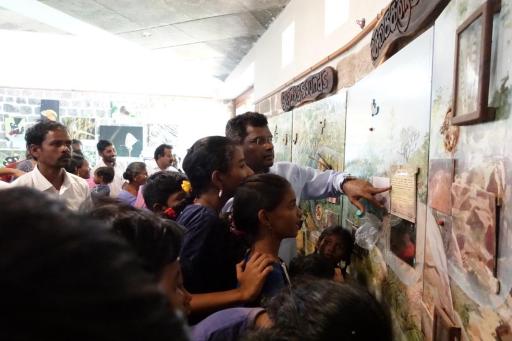
While a gang of us who have been working hard towards this day, finally get a chance to sit and make useless banter while waiting, interspersed with some runs to the kitchen to steal hot vadas to satiate our hunger, a rumble of cars approach the park gate, and there come the Collector and his entourage! We rise and get ready to welcome him. The Collector seemed thrilled to interact with all our Marudam students, not only sharing his own knowledge but also listening patiently to the shower of answers they had to his questions. He invited the Marudam kids to join him in cutting the ribbon, at last allowing everyone to enjoy Tiruvannamalai’s Nature Interpretation Centre.
As the visitors take turns to play with the sound buttons on Signs and Sounds, and pull the painstakingly engineered toggles for Who eats Whom with all their might, I stand back with my heart in my mouth, wondering whether the displays will stand the test of time and hundreds of children-hands in the days to come..
A forest in the making (planting in Adiannamalai)/ Leela
…and it’s holes upon holes upon holes, as far and as wide as the eye can see, 360 degrees all around, tucked safely (so we hope) at the foot of the ‘elephant face’ side of the hill . Thousands of burrows, waiting to be planted, each with its own special tree, a native species, but an individually unique entity, to grow and blossom into its own splendid tree, to become a part of this emerging forest.
A real forest in the making. Just there, before my eyes.
I’m going back in time, 15 years ago, to be precise. Same mountain, southern side, ‘Children park’ side. Photos and memories joined to remind me of now and then, before and after. Within 15 years the change from bare and charred to a thriving young forest is all too palpable. Not without challenges, to be certain, but some big trees already, and growing taller.
And now this.
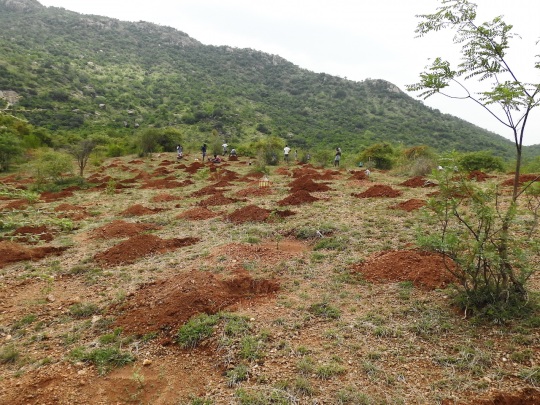
I offer a silent prayer to the trees, the soil, the rocks, the grass.
I send a silent appeal to the lord of the rains.
I take off an imaginary hat before the work of all these dedicated, unremitting diggers, planters, seed collectors and nursery workers.
As I leave the spot, I am touched and humbled, perhaps a touch more hopeful about the state of the world.
==========================
Two weeks later, on a rainy day, the mountain is shrouded in mist, another visit to the site, and this is how it looks:
The story of our bird book/ Arun
Our own bird book – ‘Birds of Thiruvannamalai’ is finally out! The book has taken us through a long journey, filled with many surprises and a lot of joy. I will try my best to recount the chronological tale of the bird book and its people.
The first conception of the book (in 2015) was as a bird guide connecting it to the birds of the region that existed as cuddapah slab paintings – creations of artist Kumar who had recorded and painted them over years. We felt it would be good to document the information, and make it more accessible. Thus Paul Hine, a senior volunteer from the UK, enthusiastically took up the project and began collating information on the birds in a bid to create a book.
The book was going to contain outline drawings of the birds on the boards with information alongside it. As the book began to take shape, however, we decided that there should be another book, containing Kumar’s birds paintings, along with text, which would serve as a guide for local bird enthusiasts.
We were spending a lot of time trying to organise the bird book as per the slabs on which they were painted. This turned out to be a tedious process as the birds were painted as and when Kumar spotted a new species, therefore not organized according to their natural groupings.
These bird species were listed and collated over nearly 10 years of bird watching. At some point of time we abandoned the idea of two books and decided to bring out one comprehensive bird book. At this point of time we had spotted 148 species. But all of a sudden, a complete pandemonium… Kumar began to spot new species ever more frequently, reaching an astonishing pace of one species a week!! Every time there was a lull from Kumar’s side, we would decide to freeze and finalize the list and publish the book at that number, but within that week Kumar would find another species, throwing the book into a period of joyous mayhem. 
There are many probable reasons for this sudden, anomalous increase in the number of birds spotted. The forests have been growing in diversity, density and stability, attracting more migrants to stay over. It is also likely that Kumar’s expertise at bird spotting has grown! and that equipped with a better camera (with better zoom) he was able to photograph more birds, which helped in the identification process. In identifying, Shantaram from Rishi Valley Bird Centre was a great help, particularly with the warblers! Jeganathan from e-bird was also a big help.
Yet another major reason for the increase in birds spotted could have been the drought in the region in 2016, which seemed to lead to a lot of local migration to previously unexplored areas in a search for resources. For example, we were totally surprised to spot a Brown fish owl near the foot hills, so far from any water body.
If 2016 was the year of the drought, then 2017 was the year of abundance. It was a bountiful year with record rainfall which filled all water bodies and that again led to a new explosion of birds. We suddenly had Pelicans, Spoonbills, and Painted storks residing in our backyard, extravagant and unexpected gifts. And just when we thought the bloom of diversity was at a crest we discovered a large, an almost perennial lake hiding quietly within the outskirts of the town. Little did we know what a giant boost to our bird count. In that area alone we recorded nearly 50 species including Bar headed geese, Woolly necked storks and even Seagulls! There were surprises on the forest species too. When we first spotted the Racket tailed drongo, we couldn’t believe it at all, as it is a bird associated with dense forests. We spotted quite a few of them in many locations in the following months. The first one was near Skanda Ashram, later near Kaatu Shiva, the Samudram Eri etc. The exhilaration on our faces soon turned to disbelieving wonder as this flamboyant mimic was followed by the White bellied drongo and the Spangled drongo – all new to the region.
The filled Samudram Lake behind our school campus become home for thousands of birds and again of many species not spotted earlier. In addition to the water birds there were many other birds along the fringes. For example, on one set of bushes we would observe hundreds of Booted warblers roosting. We also spotted the elusive Yellow bittern among the dried stalks of the crops, well camouflaged and almost impossible to see. The Zitting cisticola migrating from far north was another big surprise and delight. Through the whole of last year, evenings became delightful. Overhead, all the day birds would flock back to the lake in their hundreds and a little later night birds like the Night heron, would leave for their nocturnal abodes.
Paul in the meantime went back to the UK, and Akila more than happily stepped in to put together information on the new species being spotted. While Paul liked being brief and to the point in his presentation, Akila liked to cram in as much information as possible, as every single fact seemed fascinating and too insightful not to share. The introduction to the book, preface, details of various habitats etc. was all prepared by Govinda. Hence the book reveals quite different styles.
As Kumar grew more adept at photography, he wanted to add some of his photos as well as paintings. We decided to use both forms. Incidentally, he records all his observations on e- bird, often several times a day!
Then began the work of designing and presentation. Right through, Madhurya, an artist who has been volunteering part of the year in the project and spending the rest of the time in Nepal, has been a major resource.
When we reached 198 species, we seemed to have stopped, tantalizingly just below 200. We did all the proof reading, finalized the details and gave the material for printing.
Then came the big question, of whether to print it on regular paper or recycled paper. The difference in cost was quite marked and the regular paper would have a brighter finish. But being an afforestation project, it seemed wrong to do that. Another big question was in regards to number of copies, which would make a big difference to the cost of each book. After a lot of back and forth, we decided to print 1000 copies, keeping the cost at Rs.250/- per book.
For the last stages, Sundarmoorthy, a long term friend of the project, a web designer who designed the Forest Way website, did the finishing touches and removed all the little glitches, a painstaking work. A big thanks goes to his patience and commitment.
As this was going on, Kumar found 5 more species, and Nirmal one. (Nirmal at 12 is the youngest birder to contribute a species to the book). We added these 6 species at the end of the book, sourcing two photographs for that end from friends, as we did not have good ones ourselves.
Finally we had the bird book formally released by the Collector in February, but managed to have the book available to the public only in June. The press were very generous, giving it wide publicity, with many newspapers and online publications carrying news of it. There has been since a reasonably steady demand for the book.
Harish is currently working on a Tamizh edition of the book. As this article is being written, the number has gone up to 212! Isn’t it amazing?
Hope the forests keep growing and the numbers keep rising to present us with bouquets of feathers and chirping songs!
= = = = = = = = = = = = = = = = = = = = = = = = = = = = = =
Books are available for purchasing at the park or by online order from Arun (arun.turtle@gmail.com)
Greening work/ Govinda
The first and most important thing to mention is that we have survived yet another summer, the weather has changed, the soil is wet, and there were no devastating fires this year. So the young forest grows another year taller, another year richer. The survival of the trees planted last year is extremely heartening and humbling, and as I write this there are teams of people out digging thousands more pits for new trees, filling in gaps, adding diversity, giving our little helping effort to the glorious unfolding of the forest re-growing itself.

Apart from fire, the main impediment to the regeneration is not wood-cutting or goat herding, but the ever growing populating of spotted deer, which now range all over the Hill, and not only browse small saplings, but can kill larger young trees by rubbing their antlers on them. At the same time, they are almost certainly responsible for reducing the fire risk by eating so much of the lower level vegetation. And so no interaction in the wild is ever some simple equation, and who knows the connections and ripples of each relationship? Doesn’t stop me fantasising about returning leopards to the hill though.
On the greening front, there is an exciting new possibility on the horizon. A number of our farm/forest team come from a village about ten kilometres away called Nedungavadi, which borders a large area of scrub jungle. The area is under the Forest Department and designated as reserve forest, but is heavily degraded and under-protected. We are planning to begin regeneration work there over the course of this planting season, with a small patch of perhaps ten to twenty acres. This will give us a manageable area to begin planting and protecting while learning more about the relationships of the surrounding villages with the forest, and the specific character of the forest itself, and what it may need. We have already had positive conversations with the district forest officer in regard to this, and hope to begin in the coming weeks. The prospect of the greening work spreading out into neighbouring forest areas, and all the experience gathered by the team over the years going back into their village forest is truly exciting. Hopefully interesting stories to follow….
The Older Group Drama- Behind the scenes/ Nitya
We had not performed anything for what felt like ages. The whole idea of putting together a piece of work to display at the end of the year was more like a reminiscence of good old days than an activity of the recent past. It was quite a sudden decision then, that we were going to do a play. Things moved very fast, levels of excitement and enthusiasm ran high, and we were very lively and upbeat about the whole thing. Unfortunately, we had not yet managed to focus our energy into a cohesive or definite plan of action. All we had was the vaguest idea about plot and characters and the conviction that it shouldn’t be like the other dramas, no comedy or lighthearted messing around. We wanted to dive full-blast into something with a strong and moving message, and that was the inception of the long process that followed.
So for the first couple of weeks theatre classes were mostly spent with draining discussions which were more about who can keep quiet the longest rather than proper talking. All initial enthusiasm had died and our talks about details of who – what – and how, lead us nowhere. Perhaps it was because we had never undertook a project all by ourselves, without a teacher or a guide to take us through the process step by step. Ranjni akka was always there, but without ever pushing us or trying to make sure we worked efficiently or seriously.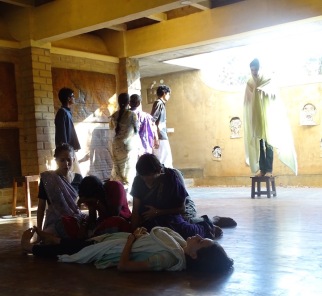
The arrival of Dhruv Anna, who introduced some theatre games to the class, followed by Alice Akka and Richard Anna, with their motivating support and encouragement had re-energised us. In just a few weeks we had progressed in leaps and bounds, and by the time Alice Akka had to say goodbye we had a proper framework and a script for the drama. The drama was to unfold around the funeral of Lakshmi, memories by the different people attending the funeral making out the scenes. Snapshots of her life- a forced marriage, an abusive husband, a society that tormented her in so many ways would emerge through out the play. We were essentially depicting the harsh realities of one hard-working, lower-class woman.
Our journey putting the act had, I would say, a fair share of ups and downs. Some even said it was more ‘the leaderless older group’s struggle of cooperating and doing something as a group’ rather than ‘Lakshmi’s life struggle’. Nevertheless, as Richard Anna kept reminding us ‘just play and enjoy’, we eventually did just that and I am happy that we managed.
—————————————
Editor’s note: The Older group finally staged the play on March 2018. It was vastly affecting and more than a few tears were shed during the performance. Beyond providing a complex and profound learning ground for the group, it stirred a relevant conversation about social justice and women’s role in society among the viewers.
A visit to Krishna’s Farm, and a trip to Sholai School and Vendanthangal
Krishna’s Farm
Last school year, the hornbill group went to the Solitude farm (run by Krishna and Deepa) of Auroville with 15 children and 3 teachers. We were greeted by Krishna anna warmly. Our aim was to experience the farm’s commitment to grow and share local and wild foods with the larger community.
During our two-day stay on the farm, Krishna anna took us for walks around the farm in which we collected thipli, sanguppoo, nannari, guava leaves, soursop leaves, an more. Krishna introduced us to the value of using locally grown vegetables, grains, pulses and fruits in everyday diet.
We later boiled all what we collected to make a juice, which was as medicinal as it was tasty! We also made medicines for our friends who had cough, and an aloevera plaster for one of our students who had some skin problem. We also helped making food baskets for regular customers. Recipes were shared with the customers, explaining how to use the produce that they find in these baskets.
We had a small circle time with Krishna, where we talked about the importance of using local resources. Krishna shared his journey in Auroville and the children related it to their own journeys in Marudam. It was a new experience for the kids to collect unconventional edible plants from the wild and turn them into delicious chutneys and salads, juices and snack items. They started being open to more creative ideas of making food which are both local, ecological and nutritious.
The next morning, we (teachers) were delighted to see some of the children getting very involved in setting up the Cafe by their own initiative. They really enjoyed working together with the akkas who, by then, had become their friends. By mid-day we made our own lunch and while at it, the kids had a ball, play-acting as customers and waiters at the cafe.
In the afternoon we all went for a walk to Fertile (Johnny Anna’s place) where the kids from the TLC school were getting ready for the TRASHATHON (fashion show of garments made from plastic and waste). The children laughed and enjoyed the different grandly designed clothes made from plastic trash. We were amazed to learn that all of this was collected on the beaches of Auroville. After that we ourselves went to the beach and believe it or not, some of us spotted a dolphin.
Back at Marudam, the children collected and made a juice from wild flowers and leaves on the farm for one of our parents’ meetings, which was enjoyed and appreciated by everyone!
— Poornima
Bird watching at Sholai School and Vedanthangal
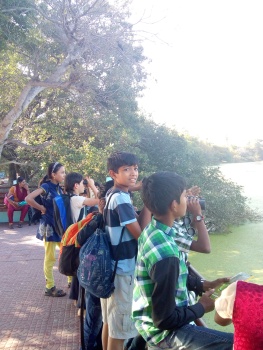
As a rule, we always try to link our trips to the topics being studied in depth. For example, we culminated our rainforest study with a stay at Gurkula Botanical Sanctuary. When we studied about the ocean, we visited Chennai and attended the turtle walks.
This year, for a group studying about birds, two trips were organized – a day trip to Vedanthangal and a three days trip to Sholai School.  The children were all very excited to observe birds in their natural habitats.
The children were all very excited to observe birds in their natural habitats.
In Vedanthangal the children were amazed to observe water birds at such close quarters. They were awed by their size and their colours. We went during the breeding season which meant some birds were building nests, while others were tending to their chicks.
Sholai School is located on the lower slopes of the Western ghats near Kodaikanal, on a beautiful campus spread over 80 acres, with coffee estates, organic farm lands and a running stream in its midst. Over 160 bird species have been observed here.
 The children were enchanted by the beautiful setting, the glamorous mountains and the much cooler weather. They went on to observe more than 60 species of birds, many new to them. They also got a chance to learn about the school’s organic farm, their craft centre and the small hydro-power plant which generates power from the running water in the stream.
The children were enchanted by the beautiful setting, the glamorous mountains and the much cooler weather. They went on to observe more than 60 species of birds, many new to them. They also got a chance to learn about the school’s organic farm, their craft centre and the small hydro-power plant which generates power from the running water in the stream.
The children also interacted with students of their age in the school and trekked to a nearby river. For some of the children it was their first trip on a train, so many new experiences!
I anchored both trips along with Pachaiappan Anna. As an avid bird watcher it was a special treat for me to be doing my favourite activity with the students.
—–Paripoornam
Thamarai Kulam/ Govinda
After a long wait for the official authorisation to come through, work on the Thamarai Kolam lake restoration began in earnest early in the summer. For those wanting to refresh on the background to this project, take a look here.
Following an initial cleanup of the lakeshore we began working on the landscaping of the area below the tank dam. This narrow strip of land is about 350 metres long and only averages 25 metres width. Even so, this is the main area of available land as the rest of the lake surrounds being built up almost to the very waterfront. And so it is this strip that will become the main body of the park, the remaining shores only providing a walking path around the lake.

Given the challenge of such a long and narrow piece of land, the plan is to create as much interest and complexity as possible in the landscape, to make it seem larger than it actually is. To achieve this, we have brought in a huge number of boulders from surrounding farms that have bulldozed them to the the edges of their fields. Although we don’t normally like using heavy machinery, this has meant playing with big toys, and the transformation of the place was quick and dramatic.
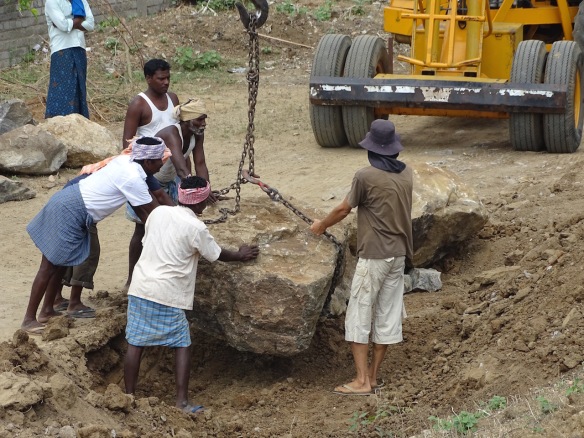
Through the summer holidays, a group of teachers and older students spent their mornings sweating away shifting soil as we started shaping the terraces and creating pathways and wheelchair access routes. It was wonderfully refreshing and lovely having them on site.

Then in the last couple of months the masons have moved in, building terrace walls, path edges and waterside platforms. All the while the regular work team is continuing with landscaping and even begun some planting. Things are moving along nicely, and in he coming months we will start the next phase, which will be the creation of the playground area.
As there is no shade from big trees as yet, the recent change of weather is hugely welcome to everyone involved in this project, as it’s been a hot summer working out in the sun. But the way the place is changing before our eyes makes it well worth while.
Birds at the Samudram lake/ Nirmal
This year has been an amazing one for bird-watchers. With the monsoons of last year filling the lake, it has seen more birds than ever!

It started with a few Ibis flocks flying above. In no time, the few turned into many and you could see as many as 80 members in one flock! Then came the cormorants, and next joined the herons, egrets and darters. Grebes and spot-billed ducks soon followed, and then came the starlings- lovely rosy starlings joined the brahminy starlings which were already there. One day I spotted the chestnut-tailed starling, which wasn’t recorded in Tiruvannamalai till then.
There were a few paddy fields at the beginning of the lake where one could see all sort of waders: red-wattled and yellow-wattled lapwings, white browed wagtail, storks nesting, yellow wagtail, purple swamp hen, common moore hens, coots…. At that time, Kumar Anna was spotting new birds by the day – water cocks, new ioras, flycatchers and leaf-birds..

After a long break from bird-watching, I went with my class to a different area of the lake where we saw Cormorants, Darters and Moor hens standing very close. We walked a step too much towards them and they flew of. When we were about to leave, a stilt came and stood 10 feet away from us! It was so beautiful… we watched it as it walked away. As we walked farther into the lake we got a great view of some Painted storks standing in the shallow water.

I was thrilled by the experience of seeing so many large birds up close! On another day, my father and I went walking around, and as we walked, we gave flight to a great many night herons. We kept walking and saw lots of storks and pelicans in the distance. I crept up to them, closer and closer, till I was only 10 feet away. I took some photos, and got back.
Some time ago we saw spoonbills flying above the lake, and later saw them as they were spooning the lake- a big flock of them, beaks submerged, going this way and that, like a dance! We came back very happy.
Now the water in the lake has almost dried up and the Ibis have left, but there are still so many birds to be seen there.
Sumanya summing up her time at Marudam
The awe I hold for Marudam as an experience has no precedent in my life. The time spent in Marudam has truly been the time spent for the soul. Volunteering in Marudam gave me an immense sense of well-being at a time when I needed it the most. It was inspiring to be part of a space wherein there existed a deep love and consideration for nature. Teaching children from such diverse backgrounds in itself was such a humbling experience; I could take chances, make mistakes and constantly learn from them greatly. I couldn’t be more grateful for such an incredible experience that I will always look back in all fondness for many many years to come.
—————————————
Sumanya Raman from Chennai has been volunteering at Marudam school for over a year. Every Monday she would take the bus from Chennai, teach various subjects in various classes, and then go back on Wednesday afternoon, always calm and amicable. She will now embark on a teaching career at the KFI School in Chennai. We wish her all the best and thank her for her work here.
Older Group Writings
I moved along the wild colourless trees without their leaves, Without the birds, without the breeze, But once within the wood I paused, hidden from the scattered light. The waves of her stopped. No splash of hope that can make my thirst go.. And I am lost here, with losses surrounding me. What more I can bare? A sudden burst of wildness or dryness.
(Kavipriya, a poem)
We dig our way out from mother earth’s intoxicated womb, stabbed by beams of white, blinding lights as the shrill exclamations of oblivious minds try welcoming us with clicking and blinking objects. We take in the poisonous fumes that perfume our breaths. A little further we hear the roar of our destinies calling us with each lick of the sandy shore. We’re guided to it by these stabbing beams held by these bulky giants that stare at us in awe, and we shuffle away from them, towards the still calling ocean. Our flippers put in use for the first time, we experiment a bit until we understand, and then we are thrust into the whole of our lives – just there, waiting ahead of us, this dark dangerous vastness that will become our everything.
(Lila, turtle hatchlings)
—————————————
Excerpts from a manual of our older group writing group. Final touches are being done to the manual which is going to be published soon.
A letter from the Farm/ Kartik
With a big rain in July, we started working on the fields, hoping as we ever would, that timely rains come. With the alluring promise of rain clouds which kept passing us for the next two months, we tilled the land and sowed different millets… but no rains turned up and the crops failed The time wasn’t great for the vegetable garden as well, except for the leafy vegetables which have kept us going. Pumpkins and yams from last year’s bumper crop held our hands for a while and we have the kitchen team to thank for stretching their imagination so that whatever came was incorporated into the meal in different ways.
The time wasn’t great for the vegetable garden as well, except for the leafy vegetables which have kept us going. Pumpkins and yams from last year’s bumper crop held our hands for a while and we have the kitchen team to thank for stretching their imagination so that whatever came was incorporated into the meal in different ways.
Writing this it is almost the end of September now and the rains are slowly peeking in. Fingers crossed.
Educational outreach at the Park/ Harish
Apart from being the nucleus of our afforestation and restoration work, the Forest Park has also been functioning as a centre for nature education for the past 10 years. Various local schools like TVS school, Arunachala Village School, Shanmuga school and local colleges have been regular participants of our Nature Education Programme. This program has been an attempt to nurture a connection for children and young adults with nature.
A typical visit will see around 30-40 children from a particular class. We usually start with an hour long discussion about a topic suggested by the children. Varied topics such as the prehistory of Tiruvannamalai, understanding local bird behavior, seasons and monsoon patterns, pollination or moon cycle are examples of topics taken up.
The discussions are followed by an hour of walk around a trail in the park. The walks are done silently and leisurely, with a focus on self directed observation. The group stops when a bird or an animal is spotted and many a time a brief tree study is also done. The walks give an opportunity for a direct connection to nature, and widens the visitors understanding of nature. The children become more receptive to life around them and every sound or small movement in the bush draws the attention of the whole group.
We have observed an interesting difference between children who come from villages and those who come from town (in a generalised way of course): Village kids usually prefers the walk part, being more at ease outdoors and walking long distances, and are in general more observant. During the discussions they tend to keep more quiet. The children from the town, on the other hand, are more receptive and participative during the discussions, and find the walks and the need for silence whilst walking challenging.
We hope that these walks are instrumental in building up a connection with nature and the local environment. Many of the students have later joined activities like garbage collection and firefighting on the hill. Some of the students come back to take a leisurely stroll on the hill even after finishing their schooling years.
This programme was anchored by Arun for many years and now I have been anchoring it since the past two years.